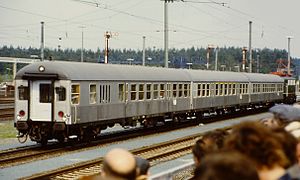N-Wagen
You can help expand this article with text translated from the corresponding article in German. (June 2017) Click [show] for important translation instructions.
|
| n-Wagen (Silberling) | |
|---|---|
 Push-pull train of n-coaches at the anniversary parade in 1985 in Nuremberg | |
| Constructed | Prototypes from 1958, 1959–1980 |
| Specifications | |
| Car length | 26,400 mm (86 ft 7+1⁄4 in) over buffers |
| Width | 2,825 mm (9 ft 3+1⁄4 in) |
| Height | 4,050 mm (13 ft 3+1⁄2 in) |
| Wheel diameter | 950 mm (3 ft 1+3⁄8 in) |
| Maximum speed | 120 or 140 km/h (75 or 87 mph) (depending on design) |
| Weight | 31–40 t (31–39 long tons; 34–44 short tons) |
| Bogies |
|
| Braking system(s) | shoe brakes; later also disc brakes |
| Seating |
|
| Track gauge | 1,435 mm (4 ft 8+1⁄2 in) |

Silberling is the colloquial name for the n-coaches of the Deutsche Bundesbahn, a type of regional passenger coach of which more than 5,000 units were built from 1958 to 1981. Nearly all of the coaches have undergone extensive modernisation – these modernised units are widely known as Mintling, Grünling ("greenling") or Rotling ("redling") after their exterior colours. The term Buntling ("colourfulling") is used to denote refurbished Silberling coaches in general.
Origin of the name
The term Silberling derives from the coaches' stainless steel body which gave them a unique look during their term of service. Translated it means "silverling" in the English language. Historically, Silberling is a silver coin and widely known from the bible: the thirty pieces of silver (in the German Bible: "30 Silberlinge", Matthew 26,14) Judas obtained for his treason.
Technical data
| Total length: | 26,400 mm |
| Distance between bogie pivots: | 21,500 mm |
| Empty weight: | 42-47 t |
| Maximum speed: | 120 or 140 km/h (varies by type) |
| Number of seats: | 96 seats in second class in Bn coaches 2×24 seats in second and 30 in first class in ABn coaches. |
Type overview
| Type | Year built | Number | Notes |
|---|---|---|---|
| ABn 703 | 1959 – 66 | 798 | 5 cars with central control (ABnz 703), 20 cars with multi-voltage heating |
| ABnr 704 | 1965 – 67 | 34 | |
| ABnrz 704 | 1968 – 77 | 380 | |
| ABnrz 708 | 1977 | 1 | Karlsruher Versuchszug (Karlsruhe experimental train) |
| Bn 719 | 1969 – 76 | 1070 | |
| Bn 720 | 1959 – 63 | 1019 | |
| Bnz 723 | 1965/66 | 30 | Multi-voltage heating |
| Bnrz 723 | 1966 | 40 | |
| Bnrz 724 | 1969/70 | 180 | Field hospital car, steep roof |
| Bnrz 724.1 | 1989/90 | 18 | remodeled from Bnrz 725 |
| Bnr 725 | 1966 – 68 | 190 | |
| Bnrz 725 | 1967 – 77 | 449 | |
| Bnrz 728 | 1977 – 80 | 100 | Steep roof |
| Bnrz 729 | 1977 | 2 | Karlsruher Versuchszug (Karlsruhe experimental train) |
| Bnrz 734 | 1977 | 1 | Karlsruher Versuchszug (Karlsruhe experimental train) |
| BDnf 735 | 1978 – 81 | 71 | Rebuilt from BDnf 738, cab car w/o door |
| BDnf 738 | 1959 – 64 | 229 | Cab car with front passenger door, 20 cars with multi-voltage heating |
| BDnrzf 739 | 1969 | 40 | Cab car with front passenger door, cab removed later on |
| BDnrzf 740 | 1971 – 77 | 310 | Cab car, model Karlsruhe |
| BDn 742 | 1961 – 64 | 29 | no cab, rebuilt from BDnf 738, 20 cars with multi-voltage heating |
- Indicator z: Central control (Zugsammelschiene)
- Indicator r: disc brakes
